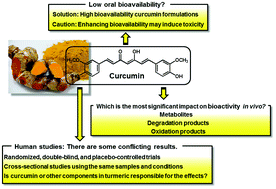Curcumin as a functional food-derived factor: degradation products, metabolites, bioactivity, and future perspectives
Abstract
Curcumin is a polyphenol found in turmeric (Curcuma longa), used as a spice, in food coloring, and as a traditional herbal medicine. It has been shown that curcumin has health benefits such as antioxidant, anti-inflammatory, and anticancer properties, improvement of brain function, and control of obesity and diabetes. However, native curcumin easily degrades and has low oral bioavailability, and a recent report has expressed doubt about curcumin's various effects. To overcome its low bioavailability, various curcumin formulations with enhanced bioavailability are currently being developed. This review discusses the chemistry, metabolism, and absorption of curcumin, to which various reported health benefits have been ascribed, as well as curcumin's degradation products and metabolites and their possible functions. Moreover, the research trend towards the obesity- and diabetes-preventing/suppressing aspects of curcumin and the latest case studies on highly water-dispersible and bioavailable curcumin formulations will be discussed. We summarize the challenges concerning research on curcumin's health benefits as follows: clarifying the relationship between curcumin's health benefits and the formation of curcumin-derived oxidation and degradation products and metabolites, determining whether curcumin itself or other components in turmeric are responsible for its effects, and conducting further human trials in which multiple research groups employ the same samples and conditions. High-bioavailability formulations would be useful in such future studies.



 Please wait while we load your content...
Please wait while we load your content...